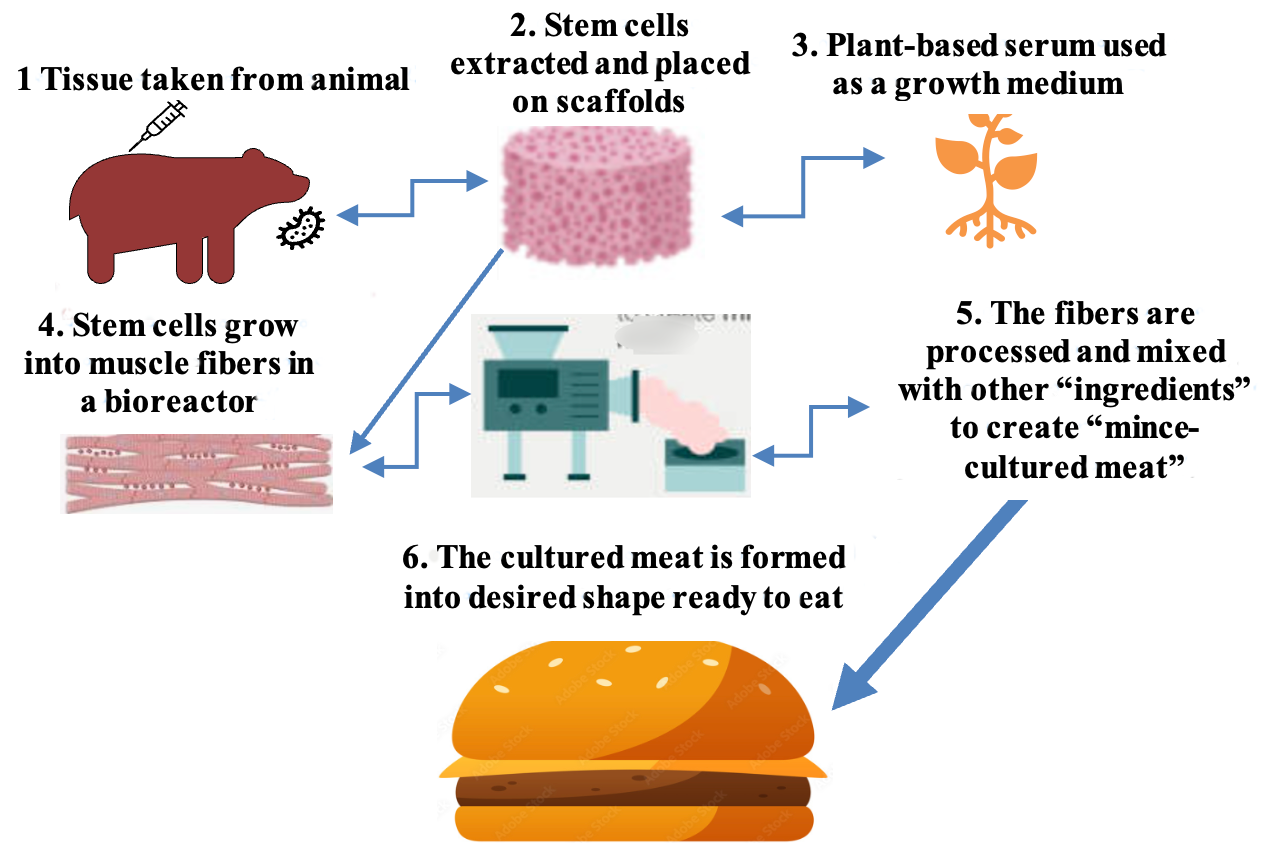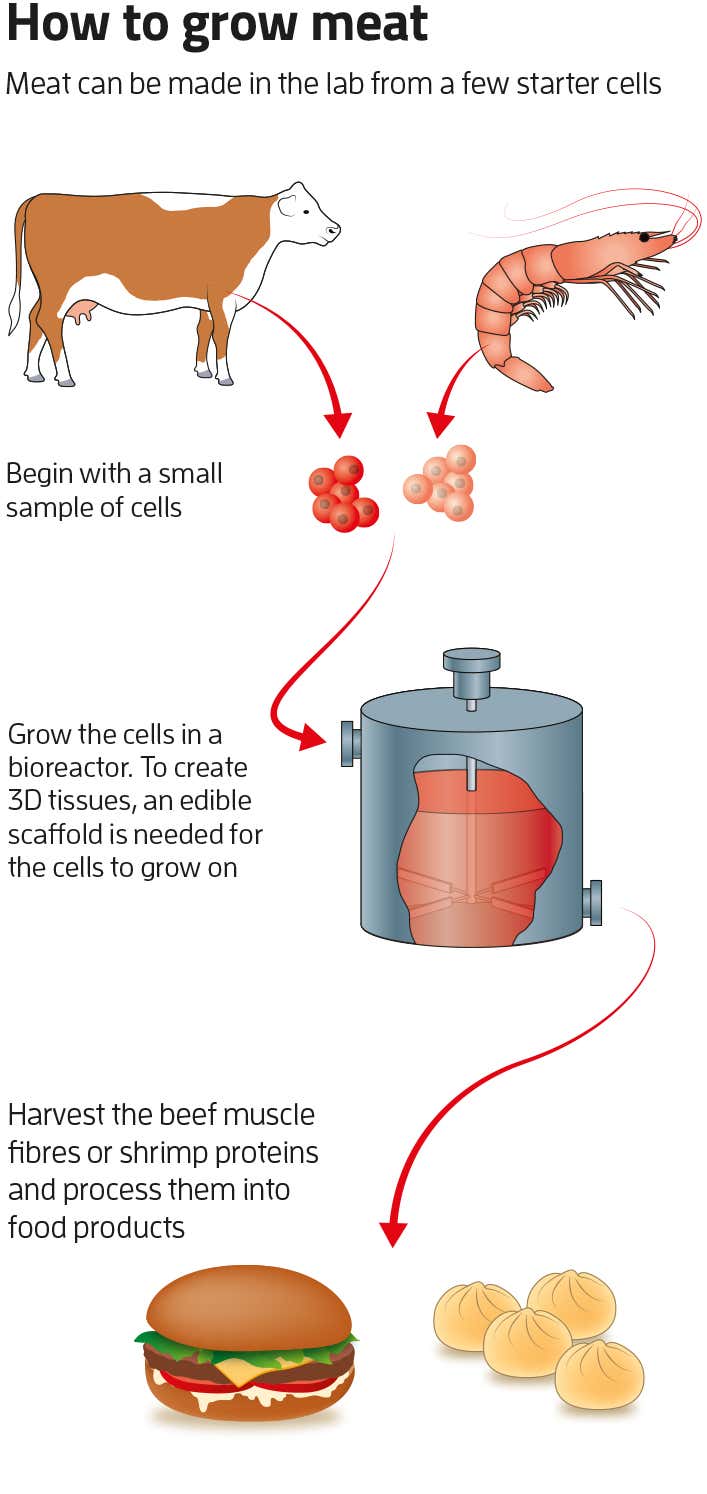I. Introduction: The Culinary Crossroads
The global appetite for meat has grown exponentially over the past century, driven by rising populations, increasing affluence, and evolving dietary preferences. While meat remains a central component of diets worldwide, this escalating demand comes with a significant environmental and ethical price tag. Traditional livestock farming is a major contributor to greenhouse gas emissions, deforestation, water pollution, and biodiversity loss. Furthermore, concerns about animal welfare in industrial farming systems are increasingly prevalent, prompting consumers and innovators alike to seek more sustainable and humane alternatives.
In response to these pressing challenges, a revolutionary concept has emerged from the intersection of biotechnology and culinary science: lab-grown meat, also known as cultivated meat, cell-based meat, or in-vitro meat. This groundbreaking innovation promises to deliver the taste, texture, and nutritional value of conventional meat without the need for raising and slaughtering animals. It represents a paradigm shift in food production, moving from the farm to the bioreactor, and has the potential to fundamentally reshape our global food systems.
This article will delve into the fascinating world of lab-grown meat, exploring the science behind its creation, the compelling benefits it offers for a more sustainable and ethical future, and the significant hurdles that must be overcome for its widespread adoption. We will also examine its potential impact on global cuisine, envisioning a future where cultivated meat is not just a niche product but a mainstream component of diverse culinary traditions. The journey of lab-grown meat from scientific curiosity to a viable food source is a testament to human ingenuity, and its future promises to be as transformative as it is delicious.
II. The Science Behind the Sizzle: How Lab-Grown Meat is Made

The concept of growing meat in a laboratory might sound like something out of science fiction, but the underlying principles are rooted in well-established biological processes. At its core, lab-grown meat is produced through a field known as cellular agriculture, which involves cultivating animal cells directly, rather than raising and slaughtering whole animals. The process, while complex in its execution, can be broken down into several key stages:
A. Cellular Agriculture Explained
The journey begins with a small sample of cells, typically taken from a living animal through a harmless biopsy. These cells are usually muscle stem cells, which have the remarkable ability to proliferate and differentiate into various cell types, including muscle and fat cells. Once collected, these cells are placed in a sterile environment and provided with a nutrient-rich growth medium. This medium, often compared to a liquid fertilizer for cells, contains all the essential elements cells need to thrive: amino acids, vitamins, minerals, sugars, and growth factors. Historically, this medium contained fetal bovine serum (FBS), a controversial component derived from animal fetuses. However, significant research and development are focused on creating serum-free, plant-based alternatives to ensure the process is entirely animal-free and more sustainable.
As the cells multiply, they need a structure to grow on, much like muscle tissue grows on a skeleton in an animal. This is where scaffolding comes into play. Scaffolds provide a three-dimensional matrix that encourages the cells to grow and organize into muscle-like structures. These scaffolds can be made from various edible materials, including plant-based proteins or even spun sugar, and are designed to mimic the natural extracellular matrix found in animal tissue.
B. From Bioreactor to Plate
Once the cells have proliferated sufficiently and are adhering to the scaffolds, they are transferred to large vessels called bioreactors. These bioreactors are essentially controlled environments that provide the optimal conditions for cell growth, including temperature, pH, and oxygen levels. Within the bioreactor, the cells continue to multiply and differentiate, forming muscle fibers and fat cells. Some processes also involve a 'conditioning' phase, where the developing tissue is subjected to mechanical or electrical stimulation to encourage the cells to develop a more realistic texture and structure, mimicking the natural development of muscle in an animal.
The final stage involves harvesting the cultivated cells and processing them into familiar meat products. For ground meat products like burgers or sausages, the cultivated cells can be directly processed and formed. For more structured cuts, like steaks or chicken breasts, the cells are grown on more complex scaffolds that guide their development into larger, more organized tissues. The cultivated meat can then be seasoned, flavored, and cooked just like conventional meat, offering a similar culinary experience. The goal is to create a product that is indistinguishable from traditional meat in terms of taste, texture, and cooking properties, making it a seamless transition for consumers.
C. Types of Cultivated Meat
The technology of cellular agriculture is not limited to just one type of meat. Researchers and companies worldwide are actively cultivating a wide range of animal cells to produce various types of meat. Beef has been a primary focus due to its significant environmental footprint in traditional agriculture. However, cultivated chicken, pork, and even seafood (like fish and shrimp) are also under development. This diversity highlights the potential for lab-grown meat to offer a comprehensive solution to the challenges posed by conventional animal agriculture across the entire spectrum of global meat consumption. Each type of cultivated meat presents its own unique scientific and engineering challenges, but the progress across all categories is rapid and promising.
III. The Promise of Cultivated Meat: Benefits for a Sustainable Future\

The advent of lab-grown meat is not merely a scientific curiosity; it represents a profound promise for addressing some of the most pressing global challenges of our time. Its potential benefits span environmental sustainability, ethical considerations, food security, and even public health, offering a compelling vision for a more responsible and resilient food system.
A. Environmental Impact
Perhaps the most widely cited benefit of cultivated meat is its significantly reduced environmental footprint compared to traditional livestock farming. Conventional meat production is a major driver of climate change, deforestation, and water pollution. Livestock farming accounts for a substantial portion of global greenhouse gas emissions, primarily methane from enteric fermentation and nitrous oxide from manure. It also requires vast tracts of land for grazing and feed crop cultivation, leading to deforestation and habitat loss. Furthermore, the industry is a significant consumer of freshwater resources and a major contributor to water pollution through runoff from farms.
In contrast, lab-grown meat production requires substantially less land, water, and emits significantly fewer greenhouse gases. While the exact figures vary depending on the specific production methods and energy sources used, studies suggest that cultivated meat could reduce land use by over 95%, water use by over 78%, and greenhouse gas emissions by over 78% compared to conventional beef production [1]. This dramatic reduction in resource intensity offers a powerful tool in the fight against climate change and environmental degradation, allowing for a more sustainable protein source for a growing global population.
B. Ethical Considerations
For many, the ethical implications of traditional animal agriculture are a primary concern. Industrial farming practices often involve the confinement of animals in crowded and unsanitary conditions, leading to significant animal welfare issues. The process of slaughter, regardless of how humanely it is conducted, is inherently a violent act. Cultivated meat offers a compelling solution to these ethical dilemmas by providing a cruelty-free meat supply. Since the meat is grown directly from cells, there is no need to raise, house, or slaughter animals for food. This eliminates the suffering of billions of animals annually, aligning food production with a more compassionate and ethical approach.
C. Food Security and Safety
Lab-grown meat also holds immense potential for enhancing global food security and safety. With a rapidly expanding global population, ensuring access to sufficient and nutritious food is a critical challenge. Cultivated meat production can be localized, reducing reliance on complex and vulnerable global supply chains. This localized production can be particularly beneficial in regions with limited arable land or water resources, providing a stable and consistent source of protein. Moreover, the controlled environment of bioreactors significantly reduces the risk of foodborne illnesses and zoonotic diseases that can originate from traditional animal farming. The sterile conditions and precise control over the growth medium minimize the presence of harmful bacteria and contaminants, leading to a safer product for consumers.
D. Nutritional Profile
Another exciting aspect of cultivated meat is the ability to control and even enhance its nutritional profile. Unlike conventional meat, where the nutritional content is largely determined by the animal's diet and genetics, lab-grown meat can be engineered to be healthier. Scientists can adjust the fat content, reduce saturated fats, and even enrich the meat with beneficial nutrients like omega-3 fatty acids, vitamins, and minerals. This opens up possibilities for creating customized meat products that cater to specific dietary needs or health goals, offering a more nutritious and tailored protein source for consumers. The potential to create healthier meat options without genetic modification of animals is a significant advantage for public health.
References:
[1] Tuomisto, H. L., & Teixeira de Mattos, M. J. (2011). Environmental Impacts of Cultured Meat Production. Environmental Science & Technology, 45(14), 6117–6123.
IV. Overcoming the Hurdles: Challenges and Innovations

Despite the immense promise of lab-grown meat, its journey from scientific breakthrough to mainstream food product is fraught with significant hurdles. Addressing these challenges requires continued innovation, substantial investment, and strategic collaboration across various sectors.
A. Cost and Scalability
One of the most formidable challenges facing the cultivated meat industry is the high cost of production and the difficulty of scaling up to meet global demand. Early prototypes of lab-grown meat were astronomically expensive, with the first cultivated burger costing over $300,000 to produce in 2013. While costs have plummeted dramatically since then, they remain significantly higher than conventional meat. The primary cost drivers include the nutrient-rich growth medium, which often contains expensive pharmaceutical-grade components, and the bioreactor technology required for large-scale cell cultivation. Innovations in developing cheaper, food-grade growth media, optimizing bioreactor designs for efficiency, and improving cell line productivity are crucial for achieving price parity with traditional meat. Companies are actively exploring plant-based alternatives for growth factors and developing continuous bioprocessing methods to reduce costs and increase output.
B. Regulatory Landscape
The regulatory landscape for lab-grown meat is complex and evolving, posing another significant hurdle. As a novel food product, cultivated meat requires rigorous safety assessments and clear regulatory frameworks before it can be sold to consumers. Different countries and regions are developing their own approaches to regulation, leading to a patchwork of rules that can hinder global market entry. For instance, Singapore was the first country to approve the sale of cultivated chicken in 2020, followed by the United States in 2023. However, many other nations are still in the process of establishing their guidelines. Navigating these diverse regulatory requirements, ensuring transparency, and building consumer trust through robust safety protocols are essential for the industry's growth.
C. Taste, Texture, and Consumer Acceptance
For lab-grown meat to truly succeed, it must deliver a sensory experience that is comparable to, if not better than, conventional meat. Mimicking the complex taste, texture, aroma, and mouthfeel of traditional meat is a significant scientific and engineering challenge. Early versions of cultivated meat often lacked the fibrous texture and marbling found in animal muscle. Researchers are working on developing more sophisticated scaffolding techniques, co-culturing muscle and fat cells, and incorporating plant-based ingredients to improve the overall sensory attributes. Beyond the technical aspects, consumer acceptance is paramount. Addressing skepticism, overcoming preconceived notions, and educating the public about the benefits and safety of cultivated meat are crucial for widespread adoption. Transparency in labeling and clear communication about the production process will play a vital role in building trust.
D. Public Perception and Marketing
Public perception is a critical factor in the success of lab-grown meat. Terms like "lab-grown" or "cultured" can sometimes evoke negative connotations, leading to consumer apprehension. Effective marketing and clear communication are necessary to frame cultivated meat as a sustainable, ethical, and safe alternative. Highlighting its environmental benefits, animal welfare advantages, and potential for enhanced nutrition can help shift public opinion. Collaborations with chefs and food influencers, as seen with the introduction of cultivated chicken in select restaurants, can also play a significant role in familiarizing consumers with the product and demonstrating its culinary potential. The industry must actively engage with consumers, address their concerns, and showcase the positive impact of this innovative food technology.
V. Lab-Grown Meat in Global Cuisine: A Culinary Revolution

The integration of lab-grown meat into global cuisine promises a culinary revolution, offering both the opportunity to replicate beloved traditional dishes and to inspire entirely new culinary creations. As cultivated meat becomes more widely available and cost-effective, its impact on how we eat and what we consider 'meat' will be profound.
A. Integration into Existing Cuisines
One of the most immediate applications of cultivated meat will be its seamless integration into existing culinary traditions worldwide. Imagine a future where classic dishes like Italian bolognese, Indian curries, Chinese stir-fries, or American burgers can be prepared with meat that is identical in taste and texture to its conventional counterpart, but without the associated environmental and ethical concerns. This allows consumers to continue enjoying their favorite meals while making a more sustainable choice. The initial focus of many cultivated meat companies has been on ground meat products, which are easier to produce and integrate into a wide variety of dishes, making them a natural entry point into the market.
B. New Culinary Creations
Beyond replication, lab-grown meat opens up exciting possibilities for novel dishes and culinary innovations. As the technology advances, it may become possible to cultivate meat with specific fat distributions, muscle fiber alignments, or even hybrid compositions that are difficult or impossible to achieve with traditional animal agriculture. This could lead to entirely new textures, flavors, and cooking properties, inspiring chefs to push the boundaries of gastronomy. Imagine a steak with a perfect, consistent marbling throughout, or a blend of different animal cells to create a unique flavor profile. The controlled environment of cellular agriculture also allows for the precise addition of nutrients or flavor compounds, potentially leading to 'designer meats' tailored for specific culinary applications or health benefits.
C. Chef and Restaurant Adoption
Chefs and restaurants are often at the forefront of culinary trends, and their adoption of cultivated meat will play a crucial role in popularizing it among consumers. Early adopters, particularly high-end restaurants and innovative chefs, have already begun to feature cultivated meat on their menus. For example, in Singapore, a Michelin-starred restaurant was among the first to serve cultivated chicken. These early showcases provide valuable opportunities for consumers to experience cultivated meat in a prepared, delicious form, helping to demystify the product and build confidence. As more chefs embrace cultivated meat, it will become increasingly normalized and desirable, accelerating its acceptance in the broader market.
D. The Future Plate
Envisioning a future where cultivated meat is a mainstream option means imagining a plate that is more diverse, sustainable, and ethical. It doesn't necessarily mean the complete disappearance of traditional meat, but rather a significant shift in consumption patterns. Cultivated meat could become a primary source of protein for many, complementing plant-based alternatives and more sustainably raised conventional meats. This future plate would offer consumers a wider array of choices, allowing them to align their dietary preferences with their values. It's a future where culinary creativity flourishes, driven by innovation that respects both the planet and its inhabitants.
VI. Conclusion: A Sustainable and Ethical Culinary Horizon
The journey of lab-grown meat from a scientific concept to a tangible food product marks a pivotal moment in the history of human sustenance. It stands as a testament to our capacity for innovation in the face of pressing global challenges. As we have explored, cultivated meat offers a compelling solution to the environmental impact, ethical concerns, and food security issues associated with traditional livestock farming.
From the intricate science of cellular agriculture to the promise of a significantly reduced ecological footprint, the benefits of lab-grown meat are clear. It provides a path towards a more sustainable protein source, one that can alleviate pressure on land and water resources, mitigate greenhouse gas emissions, and offer a cruelty-free alternative to conventional meat. While significant hurdles remain, particularly in terms of cost, scalability, and regulatory frameworks, the rapid advancements in the field demonstrate a clear trajectory towards overcoming these obstacles.
The future of lab-grown meat in global cuisine is not merely about replicating what already exists; it’s about unlocking new culinary possibilities and fostering a more diverse and resilient food system. As chefs and consumers increasingly embrace this innovation, cultivated meat has the potential to become a mainstream component of our diets, allowing us to enjoy the flavors and textures we love while aligning with our values for a healthier planet and a more ethical food chain. Continued research, strategic investment, and open dialogue will be crucial in realizing this vision. Ultimately, lab-grown meat is more than just a food product; it is a crucial component of a more sustainable, ethical, and diverse global food system, promising a culinary horizon that is both innovative and responsible.






